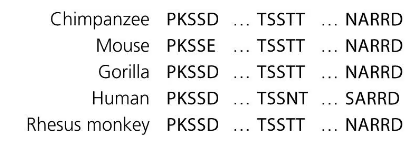 Back
Back- Bioinformatics includes (A)using DNA technology to clone genes. (B)using computer programs to align DNA sequences. (C)using a person's genomic sequence to inform decisions about medical treatment. (D)amplifying DNA segments from a species' genome.
Problem 1
Problem 1c
(c)In the human sequence, underline any amino acid that differs from the sequence for the chimpanzee, gorilla, and rhesus monkey.
Problem 2
Homeotic genes a. encode transcription factors that control the expression of genes responsible for specific anatomical structures. b. are found only in Drosophila and other arthropods. c. are the only genes that contain the homeobox domain. d. encode proteins that form anatomical structures in the fly.
Problem 3
Two eukaryotic proteins have one domain in common but are otherwise very different. Which of the following processes is most likely to have contributed to this similarity? a. gene duplication b. alternative splicing c. exon shuffling d. random point mutations
- DRAW IT Below are the amino acid sequences (using single letters; see Figure 5.14) of three short segments of the FOXP2 protein from five species. These segments contain all amino acid differences between the FOXP2 proteins of these species. Compare the amino acid sequences by answering parts (a)–(d). Chimpanzee PKSSD ... TSSTT ... NARRD Mouse PKSSE ... TSSTT ... NARRD Gorilla PKSSD ... TSSTT ... NARRD Human PKSSD ... TSSNT ... SARRD Rhesus monkey PKSSD ... TSSTT ... NARRD (a)Circle the names of any species that have identical amino acid sequences for the FOXP2 protein.
Problem 4
Problem 4b
(b)In the sequence for the mouse, circle any amino acid that differs from the sequence for the chimpanzee, gorilla, and rhesus monkey. Then draw a box around any amino acid that differs from the human sequence.
Problem 4c
Below are the amino acid sequences (using single letters; see Figure 5.14) of three short segments of the FOXP2 protein from five species. These segments contain all amino acid differences between the FOXP2 proteins of these species. Compare the amino acid sequences by answering parts (a)–(d).
b. In the sequence for the mouse, circle any amino acid that differs from the sequence for the chimpanzee, gorilla, and rhesus monkey. Then draw a box around any amino acid that differs from the human sequence.
Problem 4d
(d)Primates and rodents diverged about 65 million years ago, and chimpanzees and humans diverged about 6 million years ago (see Figure 21.17). How many amino acid differences are there between the sequence for the mouse and the sequence for the chimpanzee, gorilla, and rhesus monkey? How many amino acid differences are there between the human se-quence and the sequence for the chimpanzee, gorilla, and rhesus monkey? Based solely on the numbers of amino acid differences occurring over these time periods, what might you hypothesize about the rate of evolution of the FOXP2gene? Based on the information in the chapter regarding the FOXP2 gene, is your hypothesis correct?


